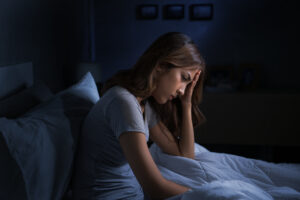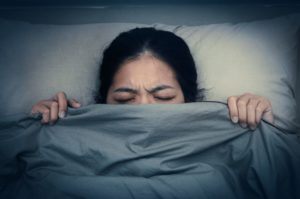Night Terrors: Causes and Tips for Prevention
- Night terrors are intense episodes of fear or terror during sleep, often accompanied by screaming or flailing.
- Episodes occur during NREM sleep and can last up to 40 minutes.
- Experts recommend against waking someone up who is experiencing a night terror.
- Common causes of night terrors include genetics, certain medications, and fever.
Night terrors cause a person to wake up in a state of extreme fear. Studies estimate 30% to 40% of young children experience night terrors at some point. Night terrors become less common after age ten, but they can also occur in adults. Learn what causes night terrors, how they differ from nightmares, how to stop night terrors, and when to see a doctor.
What Are Night Terrors?
Night terrors, also called sleep terrors, make a person wake up from sleep in a state of panic or terror. During a night terror, a person may suddenly sit up, jump out of bed, or scream. A person experiencing a night terror often displays other signs of fear, such as sweating, a rapid heart rate, and dilated pupils.
A night terror can last between 10 and 40 minutes. Usually, others cannot calm down a person having a night terror. After the night terror ends, the person who experienced it often doesn’t remember anything.
Night terrors are a form of parasomnia, a category of sleep disorders that involve unusual movements or behaviors during sleep. Night terrors occur during non-rapid eye movement (NREM) sleep. NREM sleep encompasses both light and deep sleep, but not REM sleep, the stage most associated with vivid dreaming. Since people spend more time in NREM sleep earlier in the night, night terrors are more common during the first third of a night’s sleep. This is especially true for children.
Is Your Troubled Sleep a Health Risk?
A variety of issues can cause problems sleeping. Answer three questions to understand if it’s a concern you should worry about.
What Causes Night Terrors?
Night terrors are thought to occur when someone partially wakes up, but remains in a mixed state of consciousness between sleep and wakefulness. For this reason, night terrors may also be called an arousal parasomnia or a disorder of arousal. No clear cause of night terrors has been determined yet, but multiple factors make a person more likely to experience them.
- Age: Young children are most likely to experience night terrors. They become less common with age, and most people stop having them by adolescence.
- Genetics: Multiple studies suggest that parasomnias can run in families.
- Sleep disorders: Sleep disorders that cause a person to briefly wake up throughout the night have been linked to night terrors. These include obstructive sleep apnea and periodic limb movement disorder, a condition that may be correlated with restless legs syndrome.
- Anxiety: Although night terrors are common among children, they’ve been linked to separation anxiety in some children. Adults with post-traumatic stress disorder (PTSD) or another mood disorder may be more likely to have night terrors.
- Sleep deprivation: After being deprived of sleep, a person spends more time in a deep sleep stage the next time they sleep. Since night terrors happen more from that stage, they may become more likely after sleep deprivation.
- Fever: Similarly, a fever can cause an increase in deep sleep, which may then increase the chance of night terrors.
Night Terrors vs. Nightmares: What’s the Difference?
Night terrors and nightmares differ in that only from nightmares does a person wake up feeling scared. Nightmares involve the recall of vivid, frightening dreams. Night terrors involve waking, in a state of apparent fear, but there is no remembered dream, and the sleeper may not recall waking up.
Night terrors happen during NREM sleep stages, while nightmares generally happen during REM sleep. Because of this difference, night terrors are most common in the first third of the night, and nightmares are most common in the second half of the night as the duration of REM periods lengthen.
Night Terrors in Children
Night terrors occur commonly in young children, but most stop experiencing them once they reach adolescence. A child may have night terrors a few times a month or a few times a week.
Although witnessing night terrors can be upsetting for parents and caregivers, the children having them usually do not remember that they occurred. During a night terror, a child cannot be calmed down by others, and attempts to calm them may upset them more. Children who have night terrors may also be more likely to begin sleepwalking.
Night Terrors in Adults
Up to 3% of adults experience night terrors. Night terrors among adults may be more dramatic than those in kids. An adult having a night terror may let out a piercing scream or move out of bed in a violent way. Night terrors in adults can lead to injury in some cases.
Night terrors can indicate an underlying problem in adults. Adults who have night terrors may also have post-traumatic stress disorder (PTSD), or another anxiety disorder or mental health issue.
How to Stop Night Terrors
Night terrors are usually only treated with medication when their frequency and intensity warrant. Otherwise, they’re usually managed with at-home strategies.
- Get adequate sleep: Since sleep deprivation can potentially trigger night terrors the next time a person sleeps, avoiding sleep deprivation is important. It can be important to keep a regular sleep-wake schedule with a consistent wake time and allow sufficient hours of rest to meet an individual’s sleep needs.
- Avoid triggering substances: Experts advise people with night terrors avoid consuming alcohol and caffeine, as both may increase the likelihood of night terrors. Certain medications may also trigger night terrors as a side effect and should be avoided.
- Treat underlying disorders: Disorders such as obstructive sleep apnea and periodic limb movement disorder can trigger night terrors by causing brief awakenings. As a result, treating these disorders may stop or reduce a person’s night terror episodes.
- Avoid sleep disruptions: Since night terrors tend to occur during brief awakenings, eliminating sleep disruptions may help. For example, pets can be kept out of the bedroom and efforts can be taken to block potentially disruptive noises.

Should You Wake Your Child During Night Terrors?
Experts advise against trying to wake up your child during a night terror. Trying to wake them up, restrain them, or even calm them may backfire and cause them to be more upset. Instead, try to gently guide them back to bed while speaking slowly and quietly.
Altering the child’s bedroom can help keep them safe during a night terror. For example, you could lower the mattress to the floor, set padding on the floor near the bed, keep potentially dangerous items in a separate room, lock doors and windows, and set up an alarm to indicate attempts to leave the room.
When to See a Doctor About Night Terrors
If you believe you or your child are experiencing night terrors, consider seeing a doctor.
Although night terrors are often considered normal in children, they can be difficult to distinguish from other disorders, like nocturnal seizures, panic attacks, and REM sleep behavior disorder. Night terrors may also occur more commonly in people who have other sleep or psychiatric disorders. A doctor can confirm a diagnosis of night terrors, rule out other issues, and advise on how to best manage the issue. This will usually involve undergoing an in-center sleep study.

Still have questions? Ask our community!
Join our Sleep Care Community — a trusted hub of sleep health professionals, product specialists, and people just like you. Whether you need expert sleep advice for your insomnia or you’re searching for the perfect mattress, we’ve got you covered. Get personalized guidance from the experts who know sleep best.
References
6 Sources
-
Patient education: Night terrors, confusional arousals, and nightmares in children (The Basics). (2024, February 28). UpToDate.
https://www.uptodate.com/contents/night-terrors-confusional-arousals-and-nightmares-in-children-the-basics -
Zak, R. & Karippot, A. (2024, January). Nightmares and nightmare disorder in adults. In A. Eichler & M. Friedman (Ed.). UpToDate.
https://www.uptodate.com/contents/nightmares-and-nightmare-disorder-in-adults -
Morse, A. & Kotagal, S. (2024, January). Parasomnias of childhood, including sleepwalking. In R. Chervin & A. Hoppin (Ed). UptoDate.
https://www.uptodate.com/contents/parasomnias-of-childhood-including-sleepwalking -
Foldvary-Schaefer, N. (2024, January). Disorders of arousal from non-rapid eye movement sleep in adults. In A. Avidan & A. Eichler (Ed.). UpToDate.
https://www.uptodate.com/contents/disorders-of-arousal-from-non-rapid-eye-movement-sleep-in-adults -
Van Horn, N. & Street, M. (2023, May 29). Night Terrors. StatPearls.
https://www.ncbi.nlm.nih.gov/books/NBK493222/ -
Leung, A. K. C., Leung, A. A. M., Wong, A. H. C., & Hon, K. L. (2020). Sleep Terrors: An Updated Review. Current pediatric reviews, 16(3), 176–182.
https://pubmed.ncbi.nlm.nih.gov/31612833/













